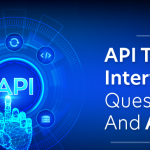JQuery Interview Questions and Answers
All excellent things are packaged neatly, and jQuery is no exception. It is a little JavaScript package that is utilised in web building and offers a fun online experience. One of the most well-known JavaScript libraries is jQuery. You can gain in-depth knowledge from jQuery Interview Questions to help you get ready for interviews.
What is jQuery?
A JavaScript library called jQuery makes it simple to construct dynamic web pages. It contributes to the efficiency and interactivity of web applications. It also contributes to the acceleration of the development process by offering a set of capabilities for data manipulation. It is a compact library that is simple to incorporate into any website.
What is jQuery used for?
The most used library on the internet right now is jQuery. It is a collection of JavaScript functions that make it simple for web designers to carry out routine operations, such as modifying the website, responding to user interactions, obtaining information from servers, creating effects and animations, and much more.
Basic jQuery Interview Questions for Freshers
1. What are the advantages of jQuery?
JQuery benefits
allows developers and programmers to write JavaScript more quickly and easily. works across a variety of browsers, therefore the code is adaptable regardless of the functionality the browser includes. less lines of code are needed to perform the most common JavaScript actions. helps you prevent frequent browser mistakes.
2. How is jQuery different from other javascript frameworks?
jQuery is significantly easier to use than JavaScript for event handling, DOM manipulation, and Ajax calls, even though JavaScript is the foundational language from which it grew. With JavaScript, it would be quite difficult and require many lines of code to add animated effects to a web page.
3. List some Features of jQuery.
The jQuery library contains the following features:
- HTML/DOM manipulation.
- CSS manipulation.
- HTML event methods.
- Effects and animations.
- AJAX.
- Utilities.
4. Is jQuery a JavaScript or JSON library file?
A JavaScript library called jQuery makes it simple to construct dynamic web pages.
5. Does jQuery work for both HTML and XML documents?
No, XML documents cannot be used with jQuery HTML; only HTML documents can.
6. What is jQuery Mobile?
An HTML5-based user interface framework called jQuery Mobile is used to create responsive websites and mobile apps that work on all smartphone, tablet, and desktop devices.
7.What is the $() function in the jQuery library?
jQuery(), which is also known as $(), searches through the DOM for any elements that match the provided selector in the first formulation listed above and generates a new jQuery object that references these elements: First, $(“div. foo”);
8.What is the exact difference between the methods onload() and document.ready()?
The key variations between the two are as follows: Body. jQuery’s document.ready() event will be called immediately the DOM is loaded, i.e., it won’t wait for the resources like images to get loaded. Onload() event will only be invoked after the DOM and associated resources like images got loaded.
9. What is the difference between JavaScript and jQuery?
As a stand-alone language, JavaScript is autonomous. The JavaScript library jQuery is used. Without JavaScript, it would not have been created. Since jQuery needs to be translated to JavaScript before the browser’s built-in JavaScript engine can understand and use it, jQuery is still dependent on JavaScript.
10. What is a CDN? What are the advantages of using CDN?
By lowering the bandwidth demands on origin servers, CDNs assist website owners in saving money on bandwidth and web hosting. In general, choosing a CDN provider will save organisations money by removing the need to invest in infrastructure, hosting, and servers all over the world.
11. Explain the use of the toggle() method in jQuery.?
The toggle() method is used to toggle between hiding and showing chosen items based on their visibility. When the element is hidden, display() is called.
12. Explain the parameters used for the jQuery Ajax method.?
One or more name/value pairs are specified in the parameters for the AJAX request. the kind of data that should be in the server response. a process to launch if the request is unsuccessful. Whether a request is only successful if the response has changed since the previous request is indicated by a Boolean value.
- Which of the following are effects in jQuery?
The four types of jQuery effects include fading, sliding, hiding/showing, and animation effects. Numerous options for effects on a web page are offered by jQuery.
14. What are events in jQuery?
The activities that are recognised by your web application are known as jQuery events. Web pages that are dynamic are made using them. An event depicts the precise second that something occurs. Here are a few instances of occurrences. one mouse click
15. What is the significance of jQuery.length?
To determine how many elements are present in a jQuery object, utilise the length attribute. The size() function also provides the jQuery object’s element count.
16. What is the purpose of JQuery’s delay() method?
We can delay the execution of functions that are in the queue after it using the delay() technique. It can be used with a custom queue or the default effects queue. Only future events in a queue are delayed; for instance, the no-arguments forms of display() and wait() are not affected by this.
17. What exactly is a jQuery Data Table plug-in?
For our website, we can add interactive and sophisticated controls to HTML tables using the DataTables contemporary jQuery plugin. It is a user-friendly jQuery plug-in with numerous options for the developer’s personalised adjustments.
18.What is the purpose of JQuery’s serialize() method?
By serialising form values, the serialise() method produces a URL-encoded text string. You have the option of choosing one or more form elements (such as an input field or text box) or only the element itself. When making an AJAX request, the serialised values can be inserted in the URL query string.
19. What are the selectors in jQuery?
HTML elements can be “found” (or chosen) with jQuery selectors based on a variety of criteria, including their name, id, classes, types, attributes, values of attributes, and much more. It is built on the current CSS Selectors and also includes some of its own unique selectors. In jQuery, each selector begins with a dollar symbol and parentheses: $ ().
20. In jQuery, distinguish between the bind(), live(), and delegate() functions.
While live() and delegate() methods also attach events to future elements, the bind() method will not do so for elements that are added after the DOM has been loaded. Delegate() and live() methods are distinct from one another in that the latter does not support chaining.
jQuery Interview Questions for Experienced
21.Explain the operation of the jQuery connect() method?
This is a jQuery plugin that is used to connect / bind a function to another function. It is more of assigning a handler for another function. Connect is used to execute a function whenever a function from another object or plugin is executed. We can connect to an event of a DOM element too using this function.
22. Distinguish between jquery.min.js and jquery.js.?
In order to save bandwidth, min. js is a compressed version of jquery. js (whitespaces and comments removed, shorter variable names, etc.). Functionality-wise, they are exactly the same.
23. Explain the benefits of using a CDN for the jQuery files.
The development of Web 2.0 applications is made simpler by the jQuery UI CDN’s facilitation of HTML client-side scripting. A jQuery download file is also a dual-licensed, open-source, and cost-free library that is distributed under the GNU General Public License. A jQuery CDN can be used by developers to build plug-ins that are added to the JavaScript library.
24. In jQuery, what is the difference between $(this) and this.
If you say $(this), jQuery will re-select your object because the $() notation in jQuery is a shortcut for the jQuery selector. The standard jQuery functions are then accessible. Consequently, this is the object that the outer jQuery call chose (JavaScript).
25. Explain the use of event.preventDefault() method.
If the event is cancellable, the preventDefault() method will do so, stopping the default action associated with the event. This can be helpful, for instance, when you want to stop a form from being submitted when you click the “Submit” button.
26. What Are the Benefits of Using Jquery Instead of Javascript in an Asp.net Web Application?
With the help of jQuery, you can perform many basic activities that would otherwise require numerous lines of JavaScript code by calling methods instead. AJAX requests and DOM manipulation are only a couple of the complex JavaScript features that are greatly simplified by jQuery.
27. What is event.stopPropagation()?
The Event interface’s stopPropagation() method stops the current event from spreading further throughout the capturing and bubbling phases. However, it does not stop any default behaviours from taking place; for instance, link clicks are still executed
28. What are the different types of selectors in jQuery?
There are three types of selectors in jQuery:
- CSS Selector
- Custom Selector
- XPath Selector
29. What is the difference between the ID selector and class selector in jQuery?
The ID selector and class selector are identical to their CSS counterparts. When selecting elements, ID selectors utilise IDs and class selectors use classes.
To choose just one element, you employ an ID selector. Use a class selector to choose a set of elements with the same CSS class.
30. What is the use of val() method in JQuery?
The value attribute of the chosen components is returned or set by the val() function. When used to return value, this function does so by giving the value of the FIRST matched element’s value property.
31. What are the two types of CDNs?
There are two types of CDN:
- Microsoft: It loads jQuery from AJAX CDN.
- Google: It loads jQuery from Google libraries API.
32. How can you disable jQuery animation?
The jQuery stop() method is used to stop an animation or effect before it is finished. The stop() method works for all jQuery effect functions, including sliding, fading and custom animations.
33.Can you explain how one can create a clone of any object using jQuery?
Use the clone() method of jQuery to duplicate an element. The clone() method selects the clones of matching DOM Elements and copies them. This can be used to move copies of the elements to another DOM position.
34.Do events also get copied when you clone an element in jQuery?
The duplicate of the matched elements is produced by the. clone() method. It does not by default copy associated events, however it does allow event handlers to be copied or not. When you need to duplicate the group of items, this makes your code easier to write.
35.How to use caching in jQuery and does it help?
With the help of the $.ajax() function from jQuery, you can send HTTP requests to servers and get responses back. To decide whether or not the browser is permitted to cache the server answer, utilise the cache option of $.ajax().
36.Can you explain the concepts of “$ function” in jQuery ?
Certainly! The jQuery function, which is used to enclose a collection of items in a jQuery object, is abbreviated as the $ function. This enables you to manipulate the set of components using the numerous built-in functions of the jQuery object.
37.Explain what Chaining is in jQuery?
Chaining in jQuery refers to the capacity to combine numerous methods in a single line of code. This is made feasible by the fact that the majority of jQuery functions return a reference to the actual jQuery object, allowing you to do extra operations on the selected element or elements.
38.Can you describe how jQuery stores data related to an element?
You can store information pertaining to an element using the data method provided by jQuery. Data is kept in an internal object connected to an element in the DOM by the data method. When you use a key and a value to call the data method, jQuery will use the key as the property name when storing the value in this internal object.
39.Can you explain the use of the jQuery load() method?
You may get the content of a file or resource and inject it into the DOM using the jQuery load() method. It’s a shortcut technique for sending a GET HTTP request and inserting the HTML that is returned into a page element.
40.Describe the use of attr() method in jQuery?
To get or set the value of an attribute for the chosen element in jQuery, use the attr() method (s).
Detailed explanation :
Here is an illustration of how to retrieve an attribute’s value using the attr() method:
//Get the value of the ‘href’ attribute of the first <a> element
Var hrefvalue = $(‘a’).first().attr(‘href’);
//Print the value of the ‘href’ attribute
console.log(hrefValue);
Here is an illustration of how to set the value of an attribute using the attr() method:
//Set the value of the ‘href’ attribute of all<a> elements to
‘http://informatiionarray.com’
$(‘a’).attr(‘href’,’http://informationarray.com’);
By giving an object containing the attribute-value pairs as the second argument, you can also set multiple attributes simultaneously using the attr() method.
//Set the ‘href’ and ‘title’ attributes of all<a> elements
$(‘a’).attr({
‘href’ :’http://informationarray.com’,
‘title’:’Visit.informationarray.com’
});
It should be noted that if the set of matched elements comprises more than one element, the attr() method only applies to the first element in the set. Use the each() function to loop over the set and set the property for each element separately if you want to set the attribute for every element in the set.
41.Can you pinpoint the main advantage of loading jQuery library using CDN?
The development of Web 2.0 applications is made simpler by the jQuery UI CDN’s facilitation of HTML client-side scripting. A jQuery download file is also a dual-licensed, open-source, and cost-free library that is distributed under the GNU General Public License. A jQuery CDN can be used by developers to build plug-ins for the JavaScript library.
42.Can you explain how would you find all selected options of HTML select tag?
You can use the jQuery :selected selector in combination with the val() method to find the selected option value in a select box or dropdown list.
Detailed explanation :
Use the selectedOptions attribute of an HTML choose element to get a list of all the chosen options.
Here is an illustration of how you may employ it:
<!DOCTYPE html>
<html>
<body>
<form>
<label for=”cars”>Choose a car:</label><br>
<select id=”cars” multiple>
<option value=”volvo”>Volvo</option>
<option value=”saab”>Saab</option>
<option value=”opel”>Opel</option>
<option value=”audi”>Audi</option>
</select>
<br></br>
<button onclick=”myFuncion()”>Submit</button>
</form>
<script>
Function myfunction() {
Var x = document.getElementById(“cars”);
Var selectedoptions=x.selectedoptions;
for(var i=0;i<selectedoptions.length; ++) {
if(selectedoptions[i].selected) {
console.log(selectedoptions[i].value);
}
}
</script>
</body>
</html>
When the submit button is pressed, the values of every option that has been selected will be recorded to the console.
It should be noted that only current browsers support the selectedOptions attribute. Use the select element’s options property to check each option’s selected property to see if it is selected if you need to support older browsers.
<!DOCTYPE html>
<html>
<body>
<form>
<label for=”cars”>Choose a car:</label><br>
<select id=”cars” multiple>
<option value=”volvo”>Volvo</option>
<option value=”saab”>Saab</option>
<option value=”opel”>Opel</option>
<option value=”audi”>Audi</option>
</select>
<br></br>
<button onclick=”myFuncion()”>Submit</button>
</form>
<script>
Function myfunction() {
Var x = document.getElementById(“cars”);
Var options=x.options;
for(var i=0; i<options.length; i++) {
if(options[i].selected) {
console.log(options[i].value);
}
}
</script>
</body>
</html>
43.What are the jQuery functions used to provide effects?
A variety of functions offered by jQuery can be used to impart effects to web page elements. These activities include:
The function fadeIn() is used to gradually introduce an element.
The function fadeOut() is used to remove an element gradually.
Using the fadeTo() function, you can gradually increase an element’s opacity.
fade
Toggle(): This function is used to change an element’s fading state.
Slide an element down using the slideDown() method.
Slide an element up using the slideUp() method.
slide
Toggle(): This function is used to switch an element’s sliding behavior.
- Can you describe the various methods for extracting a query text using regular expressions?
Using regular expressions, there are two ways to get a query string.
Using the.replace() function to compare similar regular expressions, the string-based technique helps create strings.
Standard Express-Based Method: The regular expression technique is the most effective way to extract a query string and pattern in JavaScript when compared to strings. comparing against patterns using the.exec() and.test() methods. Match(), MatchAll(), Replace(), Search(), and Split are more String functions ().
- Is it possible to pause or postpone the execution of the document. ready for a period of time?
That is certainly doable. A new method called “jQuery.holdReady(hold)” was added with the release of jQuery 1.6. The document. ready() event’s execution can be delayed using this function. When your DOM is prepared, the document.ready() event is triggered; nevertheless, there may be times when you want to load additional JavaScript or plugins that you have referenced.
- Would you still favor jQuery in a case when things can be done simply using javascript?
No. If we can achieve our objectives with straightforward JavaScript, we should forego utilising jQuery. It is because there is no need in wasting bandwidth because the jQuery library is always xx kilobytes in size. Additionally, jQuery contains many functions that are more complex than the straightforward tasks you can complete using javascript because it is built on top of javascript. All dependencies will also be loaded by jQuery. Compared to the javascript code, it will experience some speed difficulties.
In conclusion, this comprehensive guide on jQuery interview questions and answers serves as a valuable resource for job seekers and interviewers in the realm of JavaScript and front-end development. By exploring the various topics covered, such as DOM manipulation, event handling, AJAX, animations, and more, individuals can gain a deeper understanding of jQuery and its capabilities. This guide equips you with the knowledge and confidence needed to excel in jQuery interviews, showcasing your expertise in working with this popular JavaScript library. Stay up-to-date with the latest jQuery practices, enhance your front-end development skills, and confidently tackle jQuery-related questions with the help of this comprehensive resource.










